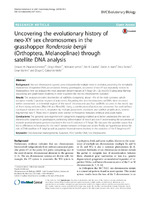| dc.creator | Palacios-Gimenez, Octavio M. | |
| dc.creator | Milani, Diogo | |
| dc.creator | Lemos, Bernardo | |
| dc.creator | Castillo, Elio Rodrigo Daniel | |
| dc.creator | Martí, Dardo Andrea | |
| dc.creator | Ramos, Érica | |
| dc.creator | Martins, César | |
| dc.creator | Cabral de Mello, Diogo Cavalcanti | |
| dc.date.accessioned | 2023-01-14T18:27:53Z | |
| dc.date.available | 2023-01-14T18:27:53Z | |
| dc.date.issued | 2018-01-08 | |
| dc.identifier.citation | Palacios-Gimenez, O. M., Milani, D., Lemos, B., Castillo, E. R. D., Martí, D. A., Ramos, E.,... Cabral-de-Mello, D. C. (2018). Uncovering the evolutionary history of neo-XY sex chromosomes in the grasshopper Ronderosia bergii (Orthoptera, Melanoplinae) through satellite DNA analysis . BMC Evolutionary Biology. Londres, Reino Unido: BioMed Central; 18 (2), 10 p. | es_AR |
| dc.identifier.issn | 1471-2148 | |
| dc.identifier.other | CCPI-CNyE-A-015 | |
| dc.identifier.other | 6336 | |
| dc.identifier.uri | https://hdl.handle.net/20.500.12219/4264 | |
| dc.description | Fil: Palacios Gimenez, Octavio M. Universidad Estatal Paulista Julio de Mesquita Filho. Instituto de Biociencias. Departamento de Biología; Brasil. | es_AR |
| dc.description | Fil: Milani, Diogo. Universidad Estatal Paulista Julio de Mesquita Filho. Instituto de Biociencias. Departamento de Biología; Brasil. | es_AR |
| dc.description | Fil: Lemos, Bernardo. Universidad de Harvard. Escuela de Salud Pública. Departamento de Salud Ambiental. Programa de Ciencias Fisiológicas Moleculares e Integrativas; Estados Unidos. | es_AR |
| dc.description | Fil: Castillo, Elio Rodrigo Daniel. Consejo Nacional de Investigaciones Científicas y Técnicas. Centro Científico Tecnológico (Nordeste). Instituto de Biología Subtropical; Argentina. | es_AR |
| dc.description | Fil: Castillo, Elio Rodrigo Daniel. Universidad Nacional de Misiones. Facultad de Ciencias Exactas, Química y Naturales. Instituto de Biología Subtropical; Argentina. | es_AR |
| dc.description | Fil: Martí, Dardo Andrea. Consejo Nacional de Investigaciones Científicas y Técnicas. Centro Científico Tecnológico (Nordeste). Instituto de Biología Subtropical; Argentina. | es_AR |
| dc.description | Fil: Martí, Dardo Andrea. Universidad Nacional de Misiones. Facultad de Ciencias Exactas, Química y Naturales. Instituto de Biología Subtropical; Argentina. | es_AR |
| dc.description | Fil: Ramos, Érica. Universidad Estatal Paulista Julio de Mesquita Filho. Instituto de Biociencias. Departamento de Morfología; Brasil. | es_AR |
| dc.description | Fil: Cabral de Mello, Diogo Cavalcanti. Universidad Estatal Paulista Julio de Mesquita Filho. Instituto de Biociencias. Departamento de Morfología; Brasil. | es_AR |
| dc.description | Fil: Martins, César. Universidad Estatal Paulista Julio de Mesquita Filho. Instituto de Biociencias. Departamento de Biología; Brasil. | es_AR |
| dc.description.abstract | Background Neo-sex chromosome systems arose independently multiple times in evolution, presenting the remarkable characteristic of repetitive DNAs accumulation. Among grasshoppers, occurrence of neo-XY was repeatedly noticed in Melanoplinae. Here we analyzed the most abundant tandem repeats of R. bergii (2n = 22, neo-XY♂) using deep Illumina sequencing and graph-based clustering in order to address the neo-sex chromosomes evolution.
Results The analyses revealed ten families of satDNAs comprising about ~1% of the male genome, which occupied mainly C-positive regions of autosomes. Regarding the sex chromosomes, satDNAs were recorded within centromeric or interstitial regions of the neo-X chromosome and four satDNAs occurred in the neo-Y, two of them being exclusive (Rber248 and Rber299). Using a combination of probes we uncovered five well-defined cytological variants for neo-Y, originated by multiple paracentric inversions and satDNA amplification, besides fragmented neo-Y. These neo-Y variants were distinct in frequency between embryos and adult males.
Conclusions The genomic data together with cytogenetic mapping enabled us to better understand the neo-sex chromosome dynamics in grasshoppers, reinforcing differentiation of neo-X and neo-Y and revealing the occurrence of multiple additional rearrangements involved in the neo-Y evolution of R. bergii. We discussed the possible causes that led to differences in frequency for the neo-Y variants between embryos and adults. Finally we hypothesize about the role of DNA satellites in R. bergii as well as putative historical events involved in the evolution of the R. bergii neo-XY. | es_AR |
| dc.format | application/pdf | |
| dc.format.extent | 1.945 MB | |
| dc.language.iso | eng | en |
| dc.publisher | BioMed Central | |
| dc.relation | info:eu-repo/semantics/altIdentifier/url/https://bmcevolbiol.biomedcentral.com/articles/10.1186/s12862-017-1113-x | |
| dc.rights | info:eu-repo/semantics/openAccess | |
| dc.rights.uri | http://creativecommons.org/licenses/by-nc-sa/4.0/ | |
| dc.subject | Chromosomal rearrangements | en |
| dc.subject | Evolution | en |
| dc.subject | FISH | en |
| dc.subject | Satellite DNA | en |
| dc.subject | Sex chromosome | en |
| dc.title | Uncovering the evolutionary history of neo-XY sex chromosomes in the grasshopper Ronderosia bergii (Orthoptera, Melanoplinae) through satellite DNA analysis | en |
| dc.type | info:eu-repo/semantics/article | |
| dc.type | info:ar-repo/semantics/artículo | |
| dc.type | info:eu-repo/semantics/publishedVersion | |




